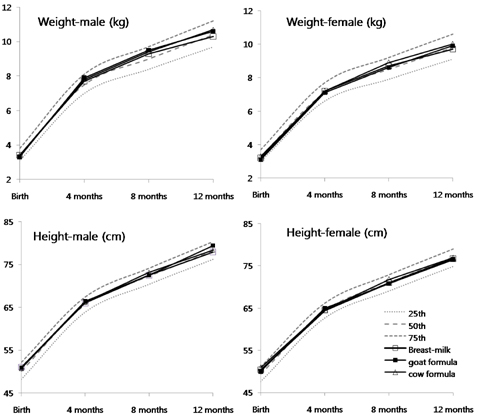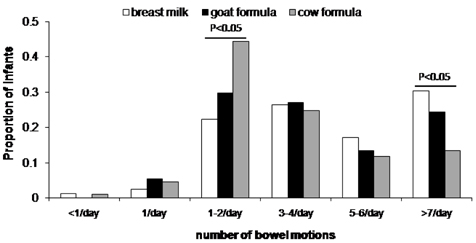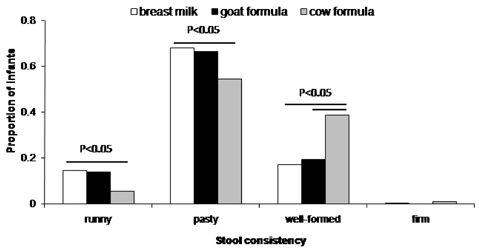Nutr Res Pract.
2011 Aug;5(4):308-312.
Association of infant feeding practices in the general population with infant growth and stool characteristics
- Affiliations
-
- 1Department of Pediatrics, Samsung Medical Center, Sungkyunkwan University School of Medicine, Seoul 135-710, Korea.
- 2Department of Pediatrics, Medical Research Institute, Pusan National University College of Medicine, Pusan 602-739, Korea.
- 3Department of Customer Service, Il Dong Foodis, Seoul 143-712, Korea.
- 4Department of R&D, Dairy Goat Co-operative (N.Z.) Ltd, Hamilton 3240, New Zealand. colin@dgc.co.nz
Abstract
- This was a prospective cohort study of 976 infants from birth to 12 months of age. Infants were fed breast milk, goat infant formula, cow infant formula, or a combination of formula and breast milk during the first 4 months of age. Data on type of milk feeding and infant growth (weight and height) were collected at birth and at 4, 8, and 12 months during routine clinical assessment. The number and consistency of bowel motions per day were recorded based on observational data supplied by the mothers. Infants fed breast milk or goat or cow infant formula during the first 4 months displayed similar growth outcomes. More of the infants fed cow infant formula had fewer and more well-formed bowel motions compared with breast-fed infants. The stool characteristics of infants fed goat formula resembled those of infants fed breast milk.
Keyword
MeSH Terms
Figure
Reference
-
1. Koletzko B, Baker S, Cleghorn G, Neto UF, Gopalan S, Hernell O, Hock QS, Jirapinyo P, Lonnerdal B, Pencharz P, Pzyrembel H, Ramirez-Mayans J, Shamir R, Turck D, Yamashiro Y, Zong-Yi D. Global standard for the composition of infant formula: recommendations of an ESPGHAN coordinated international expert group. J Pediatr Gastroenterol Nutr. 2005. 41:584–599.
Article2. Rutherfurd SM, Moughan PJ, Lowry D, Prosser CG. Amino acid composition determined using multiple hydrolysis times for three goat milk formulations. Int J Food Sci Nutr. 2008. 59:679–690.
Article3. Prosser CG, Svetashev VI, Vyssotski MV, Lowry DJ. Composition and distribution of fatty acids in triglycerides from goat infant formulas with milk fat. J Dairy Sci. 2010. 93:2857–2862.
Article4. Grant C, Rotherham B, Sharpe S, Scragg R, Thompson J, Andrews J, Wall C, Murphy J, Lowry D. Randomized, double-blind comparison of growth in infants receiving goat milk formula versus cow milk infant formula. J Paediatr Child Health. 2005. 41:564–568.
Article5. Quinlan PT, Lockton S, Irwin J, Lucas AL. The relationship between stool hardness and stool composition in breast- and formula-fed infants. J Pediatr Gastroenterol Nutr. 1995. 20:81–90.
Article6. Lloyd B, Halter RJ, Kuchan MJ, Baggs GE, Ryan AS, Masor ML. Formula tolerance in postbreastfed and exclusively formula-fed infants. Pediatrics. 1999. 103:E7.
Article7. Fomon SJ, Ziegler EE, Thomas LN, Jensen RL, Filer LJ Jr. Excretion of fat by normal full-term infants fed various milks and formulas. Am J Clin Nutr. 1970. 23:1299–1313.
Article8. Southgate DA, Widdowson EM, Smits BJ, Cooke WT, Walker CH, Mathers NP. Absorption and excretion of calcium and fat by young infants. Lancet. 1969. 1:487–489.
Article9. Murry AC Jr, Gelaye S, Casey JM, Foutz TL, Kouakou B, Arora D. Type of milk consumed can influence plasma concentrations of fatty acids and minerals and body composition in infant and weanling pigs. J Nutr. 1999. 129:132–138.
Article10. Alférez MJ, Barrionuevo M, López Aliaga I, Sanz-Sampelayo MR, Lisbona F, Robles JC, Campos MS. Digestive utilization of goat and cow milk fat in malabsorption syndrome. J Dairy Res. 2001. 68:451–461.
Article11. Almaas H, Cases AL, Devold TG, Holm H, Langsrud T, Aabakken L, Aadnoey T, Vegarud GE. In vitro digestion of bovine and caprine milk by human gastric and duodenal enzymes. Int Dairy J. 2006. 16:961–968.
Article12. Prosser CG, Mclaren RD, Frost D, Agnew M, Lowry DJ. Composition of the non-protein nitrogen fraction of goat whole milk powder and goat milk-based infant and follow-on formulae. Int J Food Sci Nutr. 2008. 59:123–133.
Article13. Singhal A, Macfarlane G, Macfarlane S, Lanigan J, Kennedy K, Elias-Jones A, Stephenson T, Dudek P, Lucas A. Dietary nucleotides and fecal microbiota in formula-fed infants: a randomized controlled trial. Am J Clin Nutr. 2008. 87:1785–1792.
Article14. Dewey KG, Heinig MJ, Nommsen LA, Peerson JM, Lönnerdal B. Growth of breast-fed and formula-fed infants from 0 to 18 months: the Darling Study. Pediatrics. 1992. 89:1035–1041.
Article15. Kramer MS, Guo T, Platt RW, Vanilovich I, Sevkovskaya Z, Dzikovich I, Michaelsen KF, Dewey K. Promotion of Breastfeeding Intervention Trials Study Group. Feeding effects on growth during infancy. J Pediatr. 2004. 145:600–605.
Article16. Heinig MJ, Nommsen LA, Peerson JM, Lonnerdal B, Dewey KG. Energy and protein intakes of breast-fed and formula-fed infants during the first year of life and their association with growth velocity: the Darling Study. Am J Clin Nutr. 1993. 58:152–161.
Article17. Agostoni C, Grandi F, Giannì ML, Silano M, Torcoletti M, Giovannini M, Riva E. Growth patterns of breast fed and formula fed infants in the first 12 months of life: an Italian study. Arch Dis Child. 1999. 81:395–399.
Article18. de Bruin NC, Degenhart HJ, Gàl S, Westerterp KR, Stijnen T, Visser HK. Energy utilization and growth in breast-fed and formula-fed infants measured prospectively during the first year of life. Am J Clin Nutr. 1998. 67:885–896.
Article19. Koletzko B, von Kries R, Closa R, Escribano J, Scaglioni S, Giovannini M, Beyer J, Demmelmair H, Gruszfeld D, Dobrzanska A, Sengier A, Langhendries JP, Rolland Cachera MF, Grote V. European Childhood Obesity Trial Study Group. Lower protein in infant formula is associated with lower weight up to age 2 y: a randomized clinical trial. Am J Clin Nutr. 2009. 89:1836–1845.
Article20. Ong KK, Emmett PM, Noble S, Ness A, Dunger DB. ALSPAC Study Team. Dietary energy intake at the age of 4 months predicts postnatal weight gain and childhood body mass index. Pediatrics. 2006. 117:e503–e508.
Article21. Dewey KG, Heinig MJ, Nommsen LA, Lönnerdal B. Adequacy of energy intake among breast-fed infants in the DARLING study: relationships to growth velocity, morbidity, and activity levels. Davis Area Research on Lactation, Infant Nutrition and Growth. J Pediatr. 1991. 119:538–547.
Article22. Koletzko B, von Kries R, Closa R, Escribano J, Scaglioni S, Giovannini M, Beyer J, Demmelmair H, Anton B, Gruszfeld D, Dobrzanska A, Sengier A, Langhendries JP, Rolland Cachera MF, Grote V. Can infant feeding choices modulate later obesity risk? Am J Clin Nutr. 2009. 89:1502S–1508S.
Article
- Full Text Links
- Actions
-
Cited
- CITED
-
- Close
- Share
- Similar articles
-
- Enteral nutrition for optimal growth in preterm infants
- A Study on feeding Practices and Growth Status of Infants and the Correlation of Mothers' Perceptions of Breast Feeding with Infant Feeding Methods in the Pocheon Area
- Enteral nutrition of the premature infant
- Review on Revised Nutrition Guidelines of the Korea National Health Screening Program for Infants and Children
- Is Definitive Surgery Necessary for Fistula-in-ano in Infant




